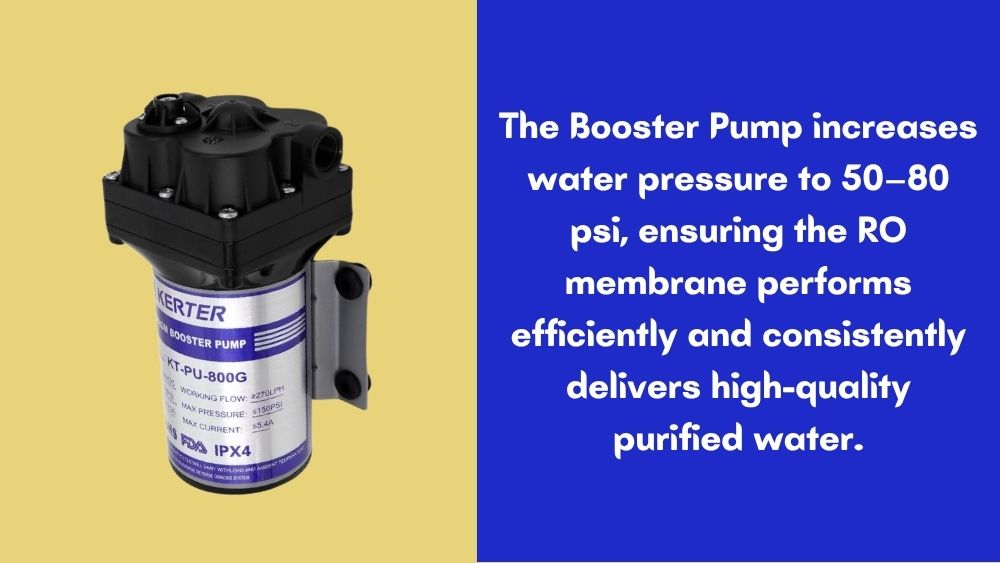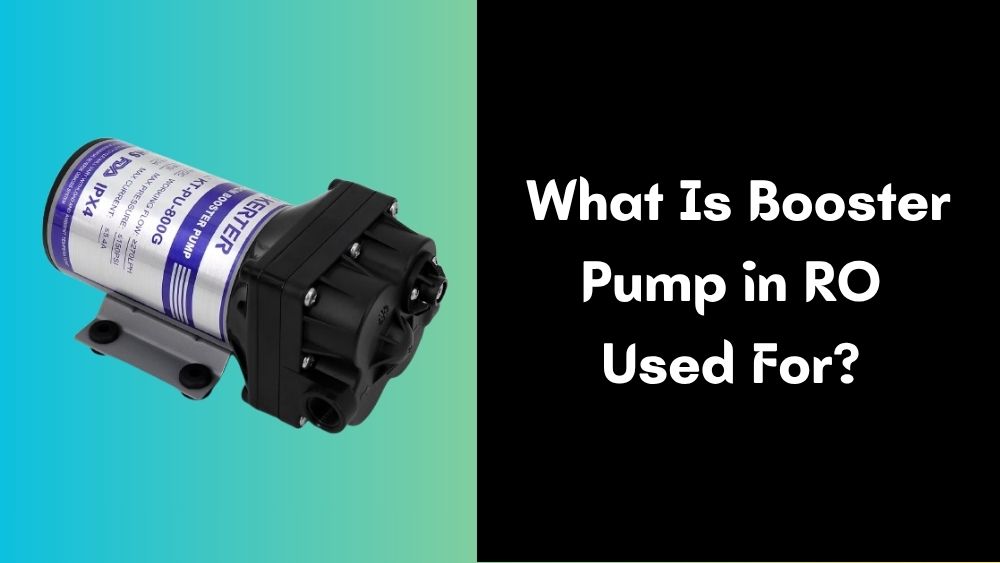Reverse osmosis (RO) systems depend on pressure to force water through a semi-permeable membrane that removes contaminants. But in areas where the incoming water pressure is low, the system struggles to perform efficiently. This is where the booster pump comes in — a small but powerful component that ensures your RO system maintains the right pressure for effective purification.
Without sufficient pressure, the RO membrane cannot separate dissolved solids properly, resulting in slow filtration and poor water quality. A booster pump increases water pressure before it enters the RO membrane, improving both performance and efficiency.
Key Takeaways
- A booster pump increases water pressure to help the RO membrane perform efficiently.
- It is essential in areas where tap water pressure is below 40 PSI.
- Booster pumps improve water output, TDS reduction, and membrane lifespan.
- They operate automatically and require minimal maintenance.
- Proper pressure ensures consistent flow and optimal water purity.
Why Pressure Matters in RO Systems
Reverse osmosis relies on hydraulic pressure to push water through a semi-permeable membrane. For most RO systems, the ideal inlet pressure is 60–80 PSI (pounds per square inch). When pressure falls below 40 PSI, filtration slows down significantly, and the system can waste more water than it produces.
The membrane needs adequate pressure to overcome osmotic pressure — the natural tendency of water to balance solute concentrations on both sides. Insufficient pressure means contaminants are not fully rejected, leading to higher TDS in filtered water.
You can learn more about how an RO system works in stages of reverse osmosis system.
What Does a Booster Pump Do?
The booster pump increases the incoming feed water pressure to the optimal level required by the RO membrane. It ensures that water molecules are pushed through efficiently, leaving behind salts, heavy metals, and other contaminants.
When connected to a transformer and pressure switch, the pump automatically turns on when the system begins producing water and turns off once the storage tank is full. This automation helps maintain energy efficiency and consistent performance.
The core functions of an RO booster pump include:
- Maintaining steady input pressure (typically 70–80 PSI)
- Increasing filtration speed
- Reducing wastewater ratio
- Enhancing total dissolved solids (TDS) removal efficiency
- Extending membrane lifespan
If your water flow feels slow or the RO unit produces less water than before, it might be time to check the booster pump’s performance or replace it.

When Is a Booster Pump Needed?
You need a booster pump if your household water pressure is below 40 PSI. This is common in homes using gravity-fed water tanks, apartments on upper floors, or rural areas with limited municipal supply.
Here’s a general pressure guide:
- Below 40 PSI – Booster pump required
- 40–60 PSI – Recommended for better efficiency
- Above 80 PSI – Not needed (use a pressure regulator)
For best results, most modern RO systems include a built-in pressure gauge to help you monitor and adjust levels easily.
How Does It Work Mechanically?
An RO booster pump consists of:
- Motor and diaphragm assembly – converts electrical energy into pressure.
- Pressure switch – automatically turns the pump on and off.
- Transformer – supplies low-voltage power for safe operation.
- Check valve – prevents reverse flow of water.
When the system starts drawing water, the low-pressure switch activates the pump. As the storage tank fills, the high-pressure switch cuts power to stop the pump. This ensures energy-efficient operation with minimal manual control.
According to RACO, typical booster pumps deliver up to 100 PSI pressure, enabling efficient membrane performance even in low-pressure areas.
Booster Pump vs. Permeate Pump vs. Standard RO
| Feature | Booster Pump | Permeate Pump | Standard RO (No Pump) |
|---|---|---|---|
| Water Pressure | Increases inlet pressure | Uses brine flow to boost | Relies on incoming pressure |
| Ideal Pressure | 70–100 PSI | 50–80 PSI | 40–60 PSI |
| Water Output | High | Moderate | Low |
| Energy Use | Requires electricity | No electricity | No electricity |
| Efficiency | High (reduces waste) | Moderate | Low |
| Best For | Low-pressure areas | Moderate-pressure homes | High-pressure supply areas |
If you’re unsure which setup you have, check the specifications of your RO system. Some tankless systems already have built-in pumps, while traditional models require an external booster kit.
For an overview of other RO system components, see 14 components parts of an RO water purifier system.
Benefits of an RO Booster Pump
1. Improved Water Flow
A booster pump increases the water production rate by up to 50%. With proper pressure, your RO system fills the storage tank faster and delivers consistent flow at the faucet.
2. Better Filtration Efficiency
The higher the pressure, the more effectively the RO membrane separates contaminants. It enhances removal of TDS, heavy metals, nitrates, and pesticides, providing cleaner and healthier drinking water.
3. Reduced Wastewater Ratio
Low-pressure systems typically waste 4–5 gallons for every 1 gallon of pure water. With a booster pump, that ratio can drop to 2:1, saving water and lowering utility costs.
4. Longer Membrane Lifespan
Optimal pressure ensures water flows evenly across the membrane, preventing scaling and clogging. This extends the lifespan of the RO membrane and other filters.
5. Stable Operation in Multi-Story Buildings
Booster pumps maintain consistent performance even when water supply pressure fluctuates — ideal for apartments or tall buildings.
Installation and Maintenance Tips
Installing a booster pump is straightforward if your system already includes compatible fittings. Most pumps are mounted between the pre-filter housing and the RO membrane inlet.
Basic steps:
- Shut off the water supply and power.
- Mount the pump on a stable surface near the RO unit.
- Connect the inlet and outlet tubing (typically 1/4-inch lines).
- Connect the transformer and pressure switch.
- Check for leaks and test the system for consistent pressure.
Maintenance is minimal — inspect tubing connections annually, and replace the pump every 3–5 years, depending on usage.
For detailed upkeep, see how to clean and sanitize an RO system.
According to Puretec Water, regular cleaning and pressure checks prevent electrical overloads and mechanical wear, ensuring your pump maintains optimal performance over time.
Common Problems and Solutions
- Pump not starting – Check transformer and low-pressure switch connections.
- Loud noise or vibration – Mount pump securely and ensure water lines aren’t kinked.
- Low output pressure – Clean pre-filters or replace membrane if clogged.
- Pump runs continuously – High-pressure switch may be faulty or tank valve leaking.
Performing a quick inspection every few months prevents most of these issues.
Expert Insight
“Pressure is the heart of reverse osmosis,” says Jason Clark, a senior engineer at a leading water purification company. “Even a high-quality RO membrane cannot function properly under low pressure. A booster pump ensures both performance and longevity of the system.”
Water quality professionals also emphasize that RO systems with booster pumps can achieve 15–20% higher contaminant rejection rates, especially for heavy metals and fluoride.
Key Points Recap
- Booster pumps are essential for low-pressure RO systems.
- They improve water output, TDS reduction, and efficiency.
- Proper pressure extends membrane life and enhances taste quality.
- Pumps require minimal maintenance but periodic checks.
- Installing one ensures consistent performance and lower water waste.
FAQs
1. What is the ideal pressure for an RO booster pump?
Most pumps operate best between 70–100 PSI, depending on the RO membrane capacity and system design.
2. Does a booster pump increase electricity use?
Only slightly. Modern pumps consume less than 24 watts, equivalent to a small LED bulb.
3. Can I install a booster pump on any RO system?
Yes. Most under-sink and tankless RO units support booster pumps, but always match voltage and pressure ratings before installation.
4. How long does an RO booster pump last?
Typically 3–5 years, though lifespan varies with water quality, usage frequency, and maintenance.
5. Do all RO systems need a booster pump?
No. Homes with municipal supply pressure above 60 PSI usually don’t need one, but adding it can still enhance efficiency and reduce wastewater.
Conclusion
A booster pump is a vital component for any reverse osmosis system operating under low water pressure. It not only improves filtration speed and efficiency but also enhances water quality while conserving resources.
If your RO system delivers slow output or poor TDS performance, installing a booster pump is an effective and affordable upgrade. With the right pressure balance, you’ll enjoy cleaner, faster, and more reliable water flow from your RO unit for years to come.
For further insights, check reverse osmosis plant diagram – a visual guide to the system and how to troubleshoot your reverse osmosis system.

Hasan Al Sarker is a Reverse Osmosis Specialist. He has worked for many years to ensure safe drinking water for all. His research paper has been published in several journals, including Issue, Medium, and Slideshare. He is recognized as a water doctor among specialists though he did not attend medical college.
Besides working as a researcher of reverse osmosis technology, he is also very fancy with the kitchen and cooking. His guides are reading thousands of people every day. As a head of content, he is responsible for all the published articles at RO System Reviews.

